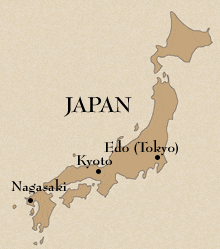
1603-1868
Tokugawa Ieyasu’s decisive victory at the Battle of Sekigahara ended more than two hundred years of violent civil war and resulted in the stable, peaceful era known as Edo. The Tokugawa shogunate relocated the political and military capital from Kyoto to Edo (modern-day Tokyo) and ruled over a tightly controlled society for the next two hundred and fifty years.
The shogunate closed Japan to the outside world with the exception of a few highly restricted trading ports in isolated parts of the country. Society was strictly divided with the samurai warrior class at the top followed by farmers, craftsmen and merchants at the bottom.
Even though they were the lowest class, the merchants grew wealthy in this peaceful society and encouraged a vibrant outpouring of the arts in Edo. Many artists, writers and performers competed for the business of the merchants as well as the patronage of the wealthy samurai.
In 1853, U.S. warships under the command of Commodore Perry demanded that Japan open its ports to trade, bringing an end to Japan’s isolationist policy. The Tokugawa shogunate unraveled and power was formally given to the Meiji emperor in 1868.
TIMELINE:
1603– Tokugawa Ieyasu (1543-1616) appoints himself shogun, formalizing Edo as the new capital from Kyoto.
1616– Tokugawa Ieyasu dies, transferring power to his sons.
1629- Women banned from the kabuki stage. Kabuki actors were often the subject of Japanese woodblock prints.
1635- Kano Sanraku dies (1559-1635). Founded Kano School, the dominant traditional approach to Japanese painting of the era.
1639- Policy of Japanese national seclusion established. Only Nagasaki Island is open, and only to traders from the Netherlands.
1641- World Event
The Dutch East India Company takes control of parts of Indonesia from the Portuguese and Moslem rulers.
1644- World event
The Ming Dynasty collapses. It had held power in China since 1368.
c. 1675- First colored woodblock prints appear in last quarter of 17th century.
1683- World event
Vienna under siege by Ottoman Turks.
1689- World event
Treaty of Nerchinsk between Russia and China halts Russian expansion into Siberia.
1716- Ogata Korin (1658-1716) dies. Korin established style known as rinpa, a major Edo style.
1738- World event
Persian emperor Nader Shah invades India.
1750- Edo has a population of 1 million people.
1765- Suzuki Harunobu invents nishiki-e, “brocade pictures,” or woodblock printing in many colors.
1776- World event
American colonies declare independence from Great Britain.
1788- World event
The Iora Australian aboriginal people welcome English settlers to Sydney Harbor, Australia.
1793- World event
The French king Louis XVI is executed four years after the French Revolution began.
1795- Maruyama Okyo (1733-1795) dies. Okyo established a lyrical, naturalistic style and trained many artists.
1799- World event
The Dutch East India Company dissolved. The company had controlled much of Europe ’s trade in the Far East.
1806- Kitagawa Utamaro (circa 1753-1806) dies. Utamaro became known for prints of insects and flowers — and beautiful women.
1819- World Event
Símon Bolívar leads Venezuela , Colombia , and Ecuador to independence from Spain. Bolívar also liberated Peru , Panama , and Bolivia.
1821- World event
Mexico becomes independent from Spain and ceases to be a colony.
1837- Peasant uprising against merchants and officials in the city of Osaka.
1841- World event
The United Provinces of Canada come into being.
1844- British and French ships visit Nagasaki and request commercial relations with Japan. Their requests are denied.
1849- Artist Katsushika Hokusai (1760-1849) dies.
1850- World event
Taipeng Rebellion, a revolt against the Manchu ruling class, begins in China.
1853- U.S. warships commanded by Matthew Perry enter Japanese waters. The country’s isolationist policy begins to unravel.
1854- Treaty of Kanagawa opens Japanese ports to U.S. ships.
1858- Ando Hiroshige (1797-1858), master of the woodblock print, dies.
1860- World event
The state of South Carolina secedes from the Union, setting off the American Civil War.
1868- Tokugawa rule ended. Emperor restored. Meiji era begins.